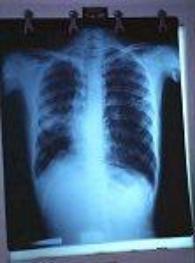2006年VOA标准英语-New TB Test Yields Quicker Results(在线收听)
By Jessica Berman
Washington
12 October 2006
Researchers have developed a new tuberculosis test that makes a diagnosis possible in a fraction of the time it can take using other methods. Experts say the test would be especially useful in the developing world, where the potentially fatal lung ailment is most common.
 |
| An X-ray of a patient affected by tuberculosis |
Researchers have been sounding the alarm recently about a resurgence of tuberculosis, especially drug-resistant strains of the disease.
The new test allows for a diagnosis in just seven days, and, it also determines whether the particular strain of tuberculosis will respond to drug treatment.
Dr. David Moore is with the Wellcome Trust Center for Clinical Tropical Medicine at Imperial College in London. He says the test that is currently most often used in the developing world, called the Lowenstein-Jensen test, takes almost a month to yield results.
"It is often very difficult to find that patient a month later," said Dr. Moore. "They tend not to come back. So, the argument against doing tests that take a month like Lowenstein-Jenson, and other slower, but inexpensive, culture-based methods, is that, actually, the clinical utility of a test that takes a month to get a result back is much diminished. In contrast, if you can have a result that takes a week, generally, it is easier to find those patients."
In conventional testing, it takes weeks to get a result because the bacteria from sputum coughed up by those suspected of having tuberculosis are grown in a sugary culture, and technicians make a determination by measuring the amount of carbon dioxide that is produced by the micro-organisms.
The new test also coaxes the TB bacteria to grow using a culture mixture, or broth. However, researchers discovered that when they examined small samples under a microscope, they could see the formation of what they call characteristic tangles in positive TB specimens. The samples are placed in tiny wells in microscope slides.
"The key thing that differs from previous studies is we examine that broth from an inverted light microscope from about the fifth day after we set the culture up to detect the characteristic growth tangles of the organism mycrobacterium tuberculosis in the broth," Dr. Moore explained. "And by adding TB drugs to some of the wells, in which the broth has been inoculated, but not to all of them, can determine whether the organism is resistant to the drugs."
Moore says, bacteria that grow in the absence of antibiotics and stop growing when exposed to the drugs, are not resistant to treatment. But if the TB microorganism grows, despite the antibiotics, it is resistant to treatment.
Moore led a field trial of the new test in Peru that found that, in every measure, including speed of detection, accuracy and detection of multi-drug resistant strains of TB, the test out-performed Lowenstein-Jensen and the automated detection test used in the West.
The study is published in the New England Journal of Medicine.
"This method not only reduces the time from conventional third world testing, it is faster than any method used in the industrialized world today," said Dr. Michael Iseman, a specialist of pulmonary diseases at the National Jewish Medical and Research Center in Denver, Colorado.
"I have done a lot of consulting in the developing world about tuberculosis," he said. "And all of us who do this have been frustrated at the inability to do drug cultures, and to do drug susceptibility testing. So in one swoop, this method has the ability to address those big problems."
But it may be a little while before the new test becomes the new "gold standard" TB test.
Iseman writes in his commentary in The New England Journal, there are concerns that not all tuberculosis strains may show the characteristic "tangles" under the microscope. And the new TB cultivation method could present bio-safety hazards that need to be addressed.